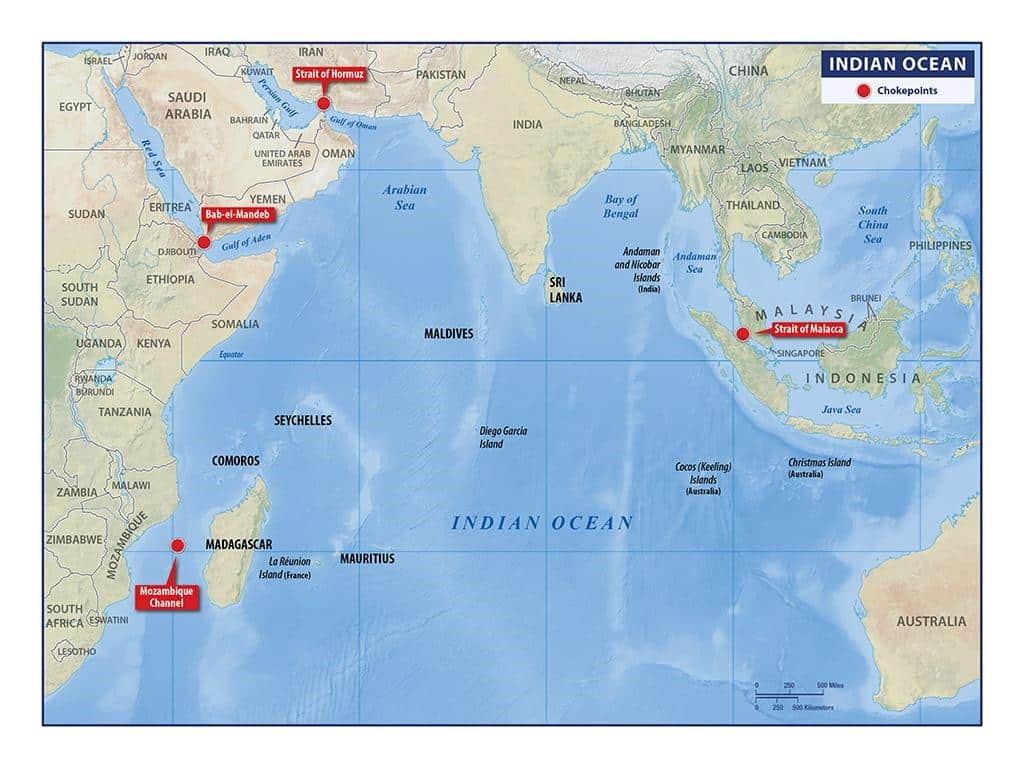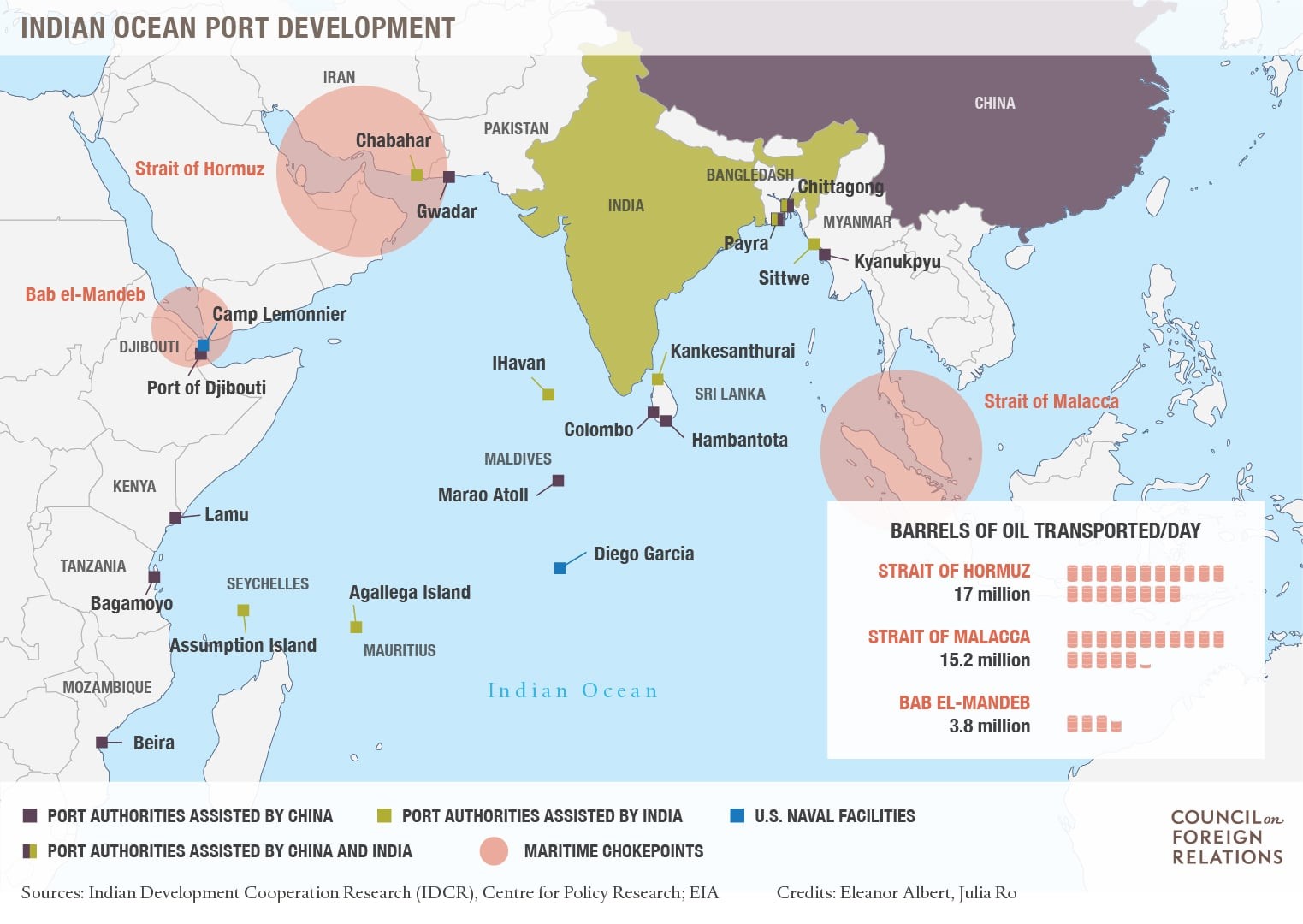



MARITIME SECURITY IN THE INDIAN OCEAN REGION

The Indian Ocean Region (IOR) holds immense strategic importance due to its vast expanse of waterways, which serve as critical arteries for global trade and commerce. However, this region is also plagued by a myriad of security challenges, ranging from piracy and maritime terrorism to territorial disputes and illegal fishing activities. In this blog, we will delve into the key challenges facing maritime security in the IOR and explore the strategies employed to address them.
Significance of IOR

Overall, the Indian Ocean Region plays a critical role in global trade, energy security, and geopolitical stability, making it a region of immense significance with diverse opportunities and challenges.
Challenges
Piracy:
One of the most pressing challenges in the IOR is piracy, particularly off the coast of Somalia. Piracy not only threatens the safety of seafarers but also disrupts maritime trade routes, leading to increased shipping costs and delays.The IOR has been a hotspot for piracy, particularly in the Gulf of Aden.The cost of piracy to the global economy was estimated to be between $7 billion and $12 billion in 2010.
Maritime Terrorism:
The IOR is vulnerable to maritime terrorism, as evidenced by the 2008 Mumbai attacks carried out by terrorists who arrived by sea. Maritime terrorist attacks can have far-reaching consequences, including economic disruption and loss of life. The IOR has been a target for terrorist attacks, including the 2008 Mumbai attacks, which killed 166 people.
Terrorist groups like Al-Qaeda and ISIS have exploited the maritime domain for smuggling weapons, drugs, and personnel.
Illegal, Unreported, and Unregulated (IUU) Fishing:
IUU fishing is a major issue in the IOR, leading to overfishing, depletion of fish stocks, and economic losses for coastal communities. It also contributes to maritime insecurity by facilitating other illicit activities.
The Food and Agriculture Organization (FAO) estimates that IUU fishing accounts for up to 26 million tons of fish caught annually, worth $10-23 billion.
IUU fishing contributes to overfishing and depletion of fish stocks, threatening food security and livelihoods in coastal communities.
Territorial Disputes:
The IOR is home to several territorial disputes, such as the disputes in the South China Sea and the India-Pakistan maritime boundary. These disputes have the potential to escalate into conflicts, further complicating the security situation in the region. The South China Sea dispute involves several countries in the IOR and has led to tensions and military buildup in the region.
The dispute between India and Pakistan over the Sir Creek area in the Arabian Sea is another example of a maritime boundary dispute in the IOR.
Trafficking:
The IOR is a major route for trafficking in drugs, arms, and people. Trafficking networks exploit the vastness of the ocean and the porosity of maritime borders, posing a challenge to maritime security forces.
The United Nations Office on Drugs and Crime (UNODC) estimates that the trafficking of drugs, arms, and people generates up to $90 billion annually.
Trafficking networks exploit the vastness of the ocean and the porosity of maritime borders, posing a challenge to maritime security forces.
Environmental Threats:
The IOR is vulnerable to environmental threats such as oil spills, which can have devastating effects on marine ecosystems and coastal communities. Climate change also poses risks, including sea level rise and extreme weather events.Environmental
Threats:
The IOR is vulnerable to environmental threats such as oil spills, which can have devastating effects on marine ecosystems and coastal communities. Climate change also poses risks, including sea level rise and extreme weather events.
Sovereignty Concerns:
The increasing presence of external powers in the IOR, including China, raises concerns about sovereignty and security for countries in the region. This has led to efforts to strengthen regional cooperation and build maritime capabilities.
China's Belt and Road Initiative (BRI) includes maritime infrastructure projects in the IOR, leading to strategic competition and concerns among regional countries.
Steps Taken by India to Address Maritime Security Challenges in the Indian Ocean Region
Anti-Piracy Operations:
India has actively participated in anti-piracy operations in the Gulf of Aden since 2008. The Indian Navy has deployed warships to escort merchant vessels, conduct patrols, and deter pirate attacks, contributing significantly to the reduction of piracy in the region.
Coastal Security:
India has implemented a Coastal Security Scheme to enhance the security of its coastal areas. This includes the establishment of coastal police stations, the deployment of patrol vessels, and the installation of surveillance systems to monitor coastal activities and prevent illicit activities.
Maritime Domain Awareness:
India has established the National Command Control Communication and Intelligence (NC3I) network to enhance maritime domain awareness. This network integrates data from various sources, including radars, AIS, and satellite imagery, to provide real-time information on maritime activities.
International Cooperation:
India has engaged in bilateral and multilateral cooperation initiatives to enhance maritime security in the IOR. For example, India has conducted coordinated patrols with countries like Indonesia and Thailand to combat piracy and enhance maritime security.
Capacity Building:
India has focused on building its maritime capabilities to address security challenges. This includes the acquisition of advanced maritime surveillance aircraft, such as the P-8I Poseidon, and the development of coastal radar chains to monitor maritime activities along its coast.
Legal Frameworks:
India has ratified and implemented international conventions and agreements related to maritime security, such as UNCLOS. India also passed the Anti-Maritime Piracy Bill in 2019, which allows for the prosecution of pirates apprehended by Indian authorities.
Humanitarian Assistance and Disaster Relief (HADR):
India has been actively involved in providing HADR assistance to countries in the IOR affected by natural disasters. The Indian Navy has conducted numerous relief operations, including Operation Rahat in Yemen in 2015 and Operation Samudra Setu during the COVID-19 pandemic.
Maritime Diplomacy:
India has engaged in maritime diplomacy to promote peace and security in the IOR. This includes initiatives like the Indian Ocean Naval Symposium (IONS) and the Indian Ocean Rim Association (IORA), which provide platforms for dialogue and cooperation among IOR countries on maritime security issues.
Organizations Working to Protect the Indian Ocean Region
Strategies to Enhance Maritime Security in the Indian Ocean Region
Establish Regional Maritime Information Fusion Centers:
Set up and enhance regional maritime information fusion centers to improve maritime domain awareness. These centers can integrate data from various sources, including radar, AIS, and satellite imagery, to provide real-time information on maritime activities.
Conduct Regular Joint Patrols and Exercises:
Organize joint maritime patrols and exercises among IOR countries to enhance coordination and interoperability in responding to maritime security threats. This can include anti-piracy operations, search and rescue missions, and disaster response exercises.
Enhance Port Security Measures:
Improve port security measures, including the installation of surveillance cameras, access control systems, and radiation detection equipment, to prevent unauthorized access and ensure the safety of maritime traffic.
Promote Maritime Domain Awareness Programs:
Implement awareness programs among maritime stakeholders, including fishermen, port authorities, and shipping companies, to enhance their understanding of maritime security threats and best practices for reporting suspicious activities.
Strengthen Legal Frameworks:
Enhance legal frameworks to combat maritime security threats, such as piracy and IUU fishing, by ratifying and implementing international conventions and agreements. This can include the United Nations Convention on the Law of the Sea (UNCLOS) and the Port State Measures Agreement (PSMA).
Enhance Cooperation with International Partners:
Strengthen cooperation with international partners, including navies from other regions and international organizations, to enhance maritime security through information sharing, capacity building, and joint operations.
Develop Maritime Infrastructure:
Invest in the development of maritime infrastructure, including ports, coastal surveillance systems, and maritime communication networks, to improve the efficiency and security of maritime activities.
Promote Sustainable Maritime Practices:
Encourage sustainable maritime practices, including the use of environmentally friendly technologies and the protection of marine biodiversity, to mitigate the environmental impact of maritime activities.
Enhance Cybersecurity Measures:
Develop and implement cybersecurity measures to protect maritime infrastructure and systems from cyber threats, including ransomware attacks and data breaches.
Engage in Diplomatic Efforts:
Engage in diplomatic efforts to resolve maritime disputes and promote peaceful cooperation among IOR countries. This can include bilateral and multilateral dialogues, confidence-building measures, and dispute resolution mechanisms.
Technology Adoption:
Embracing technological advancements, such as satellite surveillance, UAVs, and AI, to improve maritime domain awareness and response capabilities.
Joint Maritime Patrols:
Conducting joint maritime patrols among countries in the region to enhance surveillance and deterrence against maritime security threats.
Standard Operating Procedures (SOPs):
Developing and implementing SOPs for responding to maritime security incidents, including piracy, smuggling, and illegal fishing, to ensure a coordinated and effective response.
Maritime Security Exercises:
Conducting regular maritime security exercises, such as tabletop and live exercises, to enhance coordination and interoperability among maritime security forces in the region.
Enhanced Maritime Law Enforcement:
Strengthening maritime law enforcement agencies to effectively enforce laws and regulations related to maritime security, including fisheries management and pollution control.
Community Engagement:
Engaging with local communities to raise awareness about maritime security issues and promote community participation in maritime security efforts.
Regional Maritime Security Architecture:
Establishing a regional maritime security architecture to coordinate efforts and share information among countries in the region.
Intelligence Sharing:
Enhancing intelligence sharing among countries in the region to improve the detection and monitoring of maritime security threats.
Promotion of Blue Economy:
Promoting the blue economy to enhance economic opportunities in the maritime sector and reduce maritime security threats associated with poverty and unemployment.
Case Studies
Coordinated Patrols in the Malacca Strait: Indonesia, Malaysia, and Singapore conduct coordinated patrols in the Malacca Strait to enhance maritime security and combat piracy. These patrols have led to a significant reduction in piracy incidents in the region and demonstrate the effectiveness of regional cooperation in addressing maritime security threats.
Operation Atalanta: Operation Atalanta is a European Union naval mission that aims to combat piracy off the coast of Somalia. The operation has been successful in reducing piracy incidents and protecting merchant vessels transiting through the region, highlighting the importance of international cooperation in addressing maritime security challenges.
Seychelles' Blue Economy Strategy: The Seychelles has adopted a Blue Economy Strategy that focuses on sustainable development and conservation of marine resources. This initiative not only enhances maritime security by promoting sustainable practices but also contributes to economic growth and poverty alleviation in the region.
Conclusion
In conclusion, maritime security in the Indian Ocean Region (IOR) is confronted with a diverse range of challenges, including piracy, terrorism, IUU fishing, maritime boundary disputes, trafficking, environmental threats, and sovereignty concerns. These challenges not only pose immediate risks to maritime safety and security but also have broader implications for economic development, environmental sustainability, and regional stability.
Addressing these challenges requires a coordinated and cooperative approach among countries in the IOR, as well as engagement with international partners. Efforts to enhance maritime domain awareness, strengthen legal frameworks, promote sustainable maritime development, and build capacity for maritime security forces are essential. Additionally, fostering trust and cooperation among stakeholders in the region is crucial for effectively addressing these challenges and ensuring a safe and secure maritime environment in the Indian Ocean Region.
© 2025 iasgyan. All right reserved